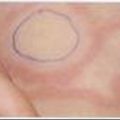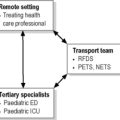7.5 Bilious vomiting
Causes
The possible causes of bilious vomiting are as shown in Table 7.5.1 and are discussed below:
Intestinal atresia
As the lesion is congenital, the child will present in the neonatal period, although increasingly, some of these infants are diagnosed on antenatal ultrasound scans.1 Proximal lesions, such as duodenal or jejunal atresia, will usually present in the first 24 hours of life whereas more distal lesions, such as ileal or colonic atresias, can present later. Duodenal atresia may be associated with Down’s syndrome and cardiac anomalies in up to 30% of cases.2
Anorectal anomalies
Typically the anus is imperforate and the rectum communicates with the urinary tract or perineum via a fistula. It may occur as part of the VACTERL association of anomalies (vertebral, anorectal, cardiac, tracheo-oesophageal, renal and limb).3 The diagnosis should normally be made as part of the routine assessment of a neonate following delivery, but is occasionally missed, leading to a complete or partial distal obstruction and late onset bilious vomiting. Infrequently, the anomaly may present outside the neonatal period once the child commences solids.
Meconium ileus
This condition occurs in about 10–20% of neonates with cystic fibrosis (CF), although uncommonly it may occur in the absence of CF.4 There may be a family history of CF. The condition results from the occlusion of the bowel lumen by abnormally viscous enteric secretions in the small bowel and may be complicated by an atresia.
Hirschsprung’s disease
In this condition the enteric nervous system is abnormal, leading to a distal physiological obstruction. The condition is more common in males by a ratio of 4:1.5 In 75% of cases, so called ‘classical’ Hirschsprung’s disease (HD), a variable extent of the rectum and sigmoid colon is involved, leading to a distal colonic obstruction.6 In the remaining 25% of cases, bowel proximal to the sigmoid colon will also be aganglionic. About 10% of children with HD will also have Down’s syndrome.7 The cardinal feature of HD is the failure to first pass meconium within 24 hours of birth in a term infant, with the later development of bilious vomiting in the first few days of life.
Malrotation with volvulus
The mid-gut normally develops within a physiological hernia in utero. As this reduces towards the end of the first trimester, the mid-gut undergoes an anticlockwise rotation around the axis of the superior mesenteric vessels.8 Failure of this process to occur results in malrotation. The onset of bilious vomiting usually indicates that the malrotated small bowel has obstructed as a result of twisting around its pedicle, although occasionally, this may occur as a result of associated congenital bands. There is a high risk of intestinal ischaemia, so urgent surgical intervention is required once the diagnosis has been confirmed.9 Although malrotation most commonly presents in the first month of life, it can present at any time and even in adult life.10
Intussusception
In intussusception the proximal bowel (the ‘intussusceptum’) invaginates or telescopes into the distal, receiving bowel (the ‘intussuscipiens’). Initially this involves the ileum invaginating into itself, but then progresses to involve the colon. Most commonly, it presents in infants or toddlers with episodic colicky abdominal pain, which may be associated with vomiting or pallor. As the disease progresses, vomiting may become bilious, resulting from intestinal obstruction. The ‘classical’ redcurrant jelly stool of intussusception is a late phenomenon but occult blood can often be detected earlier.11
In older children above 3 years of age, intussusception is usually associated with a pathological lead point such as a Meckel’s diverticulum (MD) or small bowel polyp.12 It may also complicate CF and Henoch–Schönlein purpura.
Meckel’s diverticulum
This represents a remnant of the omphalomesenteric duct and is present in about 2% of the population.13 For reasons that are unclear, complications of a MD are more common in males.13 MD may lead to a bowel obstruction either as a result of acting as the lead point for an intussusception, due to an associated band adhesion with volvulus or an internal hernia, or rarely an inflammatory mass due to Meckel’s diverticulitis.
Adhesions
Bowel obstruction due to adhesions is uncommon in children following abdominal surgery.9 This is fortunate as, unlike adults, the obstruction rarely settles with non-operative intervention.
Non-surgical
A wide variety of medical conditions may occasionally present with bilious vomiting, together with a variable degree of abdominal distension. Severe gastroenteritis with prolonged vomiting, sepsis, pyloric stenosis, hypothyroidism, meconium plug syndrome and the cyclical vomiting syndrome may all lead to a clinical picture similar to intestinal obstruction.14 Any child presenting with bilious vomiting, however, requires paediatric surgical consultation to exclude a surgical cause.
Complications
The major complication of bilious vomiting due to intestinal obstruction is the potential for intestinal ischaemia if the diagnosis is delayed. Even short periods of ischaemia may lead to loss of the normal gut barrier function and a prolonged paralytic ileus. If there has been diagnostic delay with irreversible bowel ischaemia, perforation with peritoneal contamination can occur. In cases requiring extensive resection, short-bowel syndrome can result. In unrecognised cases, overwhelming septicaemia and even death can result.9
Investigations
The initial radiological investigations should be directed towards demonstrating obstruction and include plain films of the abdomen and chest. Free gas from a perforation can be seen on an erect chest, erect abdomen or decubitus abdominal views. Fluid levels consistent with intestinal obstruction may be seen on an erect or decubitus abdominal film, but can be normal and may occasionally occur in medical causes of bilious vomiting. Dilated small bowel is identified by the presence of the valvulae conniventes of Kirkring passing across the entire lumen, as opposed to the incomplete haustral markings in the colon. In neonates, these markings are usually not visible. There may be features to suggest intussusception (see Chapter 7.1 on Abdominal pain).
The use of further investigations will be directed by the likely pathology and surgical consultation. Contrast studies, either upper or lower, may be both diagnostic of the surgical cause and in the case of intussusception, potentially therapeutic, although now generally replaced by the safer air enema.8,11 Ultrasound (US) has a limited role in the investigation of bilious vomiting, but may be useful as a screening tool in children with suspected intussusception and the detection of pathological lead points.15 Whilst malrotation may be diagnostic of malrotation, it cannot be relied upon to exclude the diagnosis.16
Treatment
The child should be fasted. Neonates and infants require a warm environment to ensure temperature stability. Often large volumes of fluid have been lost from the intravascular space and 10–20 mL kg–1 fluid boluses of crystalloid solution may be required to treat shock. In addition, calculated maintenance and deficit fluid using half-strength normal saline with dextrose should be given. A gastric tube, at least 10 or 12F in size should be placed and regularly aspirated to decompress the stomach. Ongoing fluid losses should be charted and replaced on a mL for mL basis with intravenous normal saline. Hypokalaemia, if present, needs to be treated appropriately (see Chapter 10.5 on fluids and electrolytes). If required, intravenous analgesia should be given in the form of morphine 100 mcg kg–1 per dose and titrated to the response of the patient.
Most surgical causes of bilious vomiting will require operative treatment following further investigation.9 Although adhesive obstruction may initially be treated non-operatively by a 24 to 48 hour period of gut rest, only rarely is this effective in children.
 Radiological diagnosis of malrotation. False positives and negatives may occur with both contrast studies and US assessment.17 Ultimately the clinician needs to make an assessment based on the patient’s signs and symptoms in conjunction with information obtained from radiological studies.
Radiological diagnosis of malrotation. False positives and negatives may occur with both contrast studies and US assessment.17 Ultimately the clinician needs to make an assessment based on the patient’s signs and symptoms in conjunction with information obtained from radiological studies. The role of laparoscopy in the assessment of small bowel obstruction in children.18 There may be a role for laparoscopy as the first manoeuvre in the operative management of children with adhesive intestinal obstruction.
The role of laparoscopy in the assessment of small bowel obstruction in children.18 There may be a role for laparoscopy as the first manoeuvre in the operative management of children with adhesive intestinal obstruction.1 Dalla Vecchia L.K., Grosfeld J.L., West K.W., et al. Intestinal atresia and stenosis: A 25-year experience with 277 cases. Arch Surg. 1998;133:490-497.
2 Grosfeld J.L., Rescorla F.J. Duodenal atresia and stenosis: Reassessment of treatment and outcome based on antenatal diagnosis, pathologic variance and long-term follow-up. World J Surg. 1993;17:301-309.
3 Paidas C.N., Pena A. Rectum and anus. In: Oldham K.T., Colombani P.M., Foglia R.P., editors. Surgery of infants and children: Scientific principles and practice. Philidelphia: Lippincott-Raven Publishers; 1997:1323-1362.
4 Fakhoury K., Durie P.R., Levison H., Canny G.J. Meconium ileus in the absence of cystic fibrosis. Arch Dis Child. 1992;67:1204-1206.
5 Russell M.B., Russell C.A., Niebuhr E. An epidemiological study of Hirschsprung’s disease and additional anomalies. Acta Paediatr. 1994;83:68-71.
6 Kleinhaus S., Boley S.J., Sheran M., et al. Hirschsprung’s disease: A survey of members of the surgical section of the American Academy of Paediatrics. J Pediatr Surg. 1979;14:588-597.
7 Goldberg E. An epidemiological study of Hirschsprung’s disease. Int J Epidemiol. 1984;13:479-485.
8 Rowe M.I., O’Neill J.A., Grosfeld J.L., et al. Rotational anomalies and volvulus. In: Rowe M.I., O’Neill J.A., Grosfeld J.L., Fonkalsrud E.W., Coran A.G., editors. Essentials of paediatric surgery. St Louis: Mosby; 1995:492-500.
9 Madonna M.B., Boswell W.C., Arensman R.M. Outcomes. Semin Pediatr Surg. 1997;6(2):105-111.
10 Powell D.M., Otherson H.B., Smith C.D. Malrotation of the intestine in children: The effect of age in presentation and therapy. J Pediatr Surg. 1989;24:777-780.
11 Losek J.D., Fiete R.L. Intussusception and the diagnostic value of testing stool for occult blood. Am J Emerg Med. 1991;9:1-3.
12 Ong N.T., Beasley S.W. The leadpoint in intussusception. J Pediatr Surg. 1990;25:640-643.
13 St-Vil D., Brandt M.L., Panic S., et al. Meckel’s diverticulum in children: A 20-year review. J Paediatr Surg. 1991;26:1289-1292.
14 Li B.U.K., Balint J.P. Cyclic vomiting syndrome: Evolution in our understanding of a brain-gut disorder. Adv Pediatr. 2000;47:117-160.
15 Bhisitkul D.M., Listernick R., Shkolnik A., et al. Clinical application of ultrasonography in the diagnosis of intussusception. J Pediatr. 1992;121:182-186.
16 Millar A.J.W., Rode H., Cywes S. Malrotation and volvulus in infancy and childhood. Semin Pediatr Surg. 2003;12:229-236.
17 Dilley A.V., Pereira J., Shi E.C.P., et al. The radiologist says malrotation: Does the surgeon operate? Pediatr Surg Int. 2000;16:45-49.




